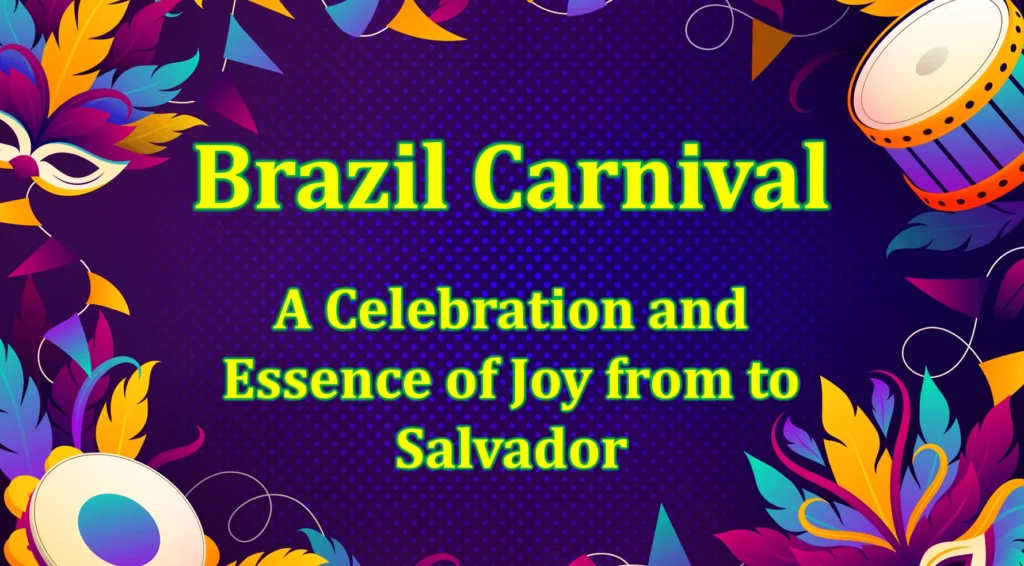
Introduction to Brazil Carnival
Origin of Brazilian Carnival
Roots of Brazilian Carnival has deep cultural origins that can be traced back to the 16th century. The event was introduced by the Portuguese who the concept of carnival from Europe. However, the influence of African, Indigenous, and European traditions gave birth to the unique and vibrant celebration we know today.
Influences from African, Indigenous, and European traditions
The rich cultural melting pot of Brazil has shaped the Carnival into a fascinating blend traditions. African slaves their music and dance styles Indigenous people added their rituals and beliefs, and European influences brought elements like costumes and masks. The infusion of these diverse cultures has created a dynamic and inclusive celebration.
The significance of Carnaval in religious and social contexts
Carnaval holds immense religious and social significance for the people of Brazil. It originated as a pre-Lenten celebration, serving as a way for people to indulge in excesses before the 40 days of fasting and penance. Over time, it evolved into a joyful expression of freedom and unity, bringing people from all walks of life together.
Evolution of Brazil Carnival Through the Years
The transformation from private parties to public spectacles
Brazil Carnival has come a long way from its humble beginnings as private parties held by the elite. It gradually transformed into massive public spectacles in the late 19th century when the working class started organizing their own parades. Today, it has become one of the largest street festivals in the world, attracting millions of visitors.
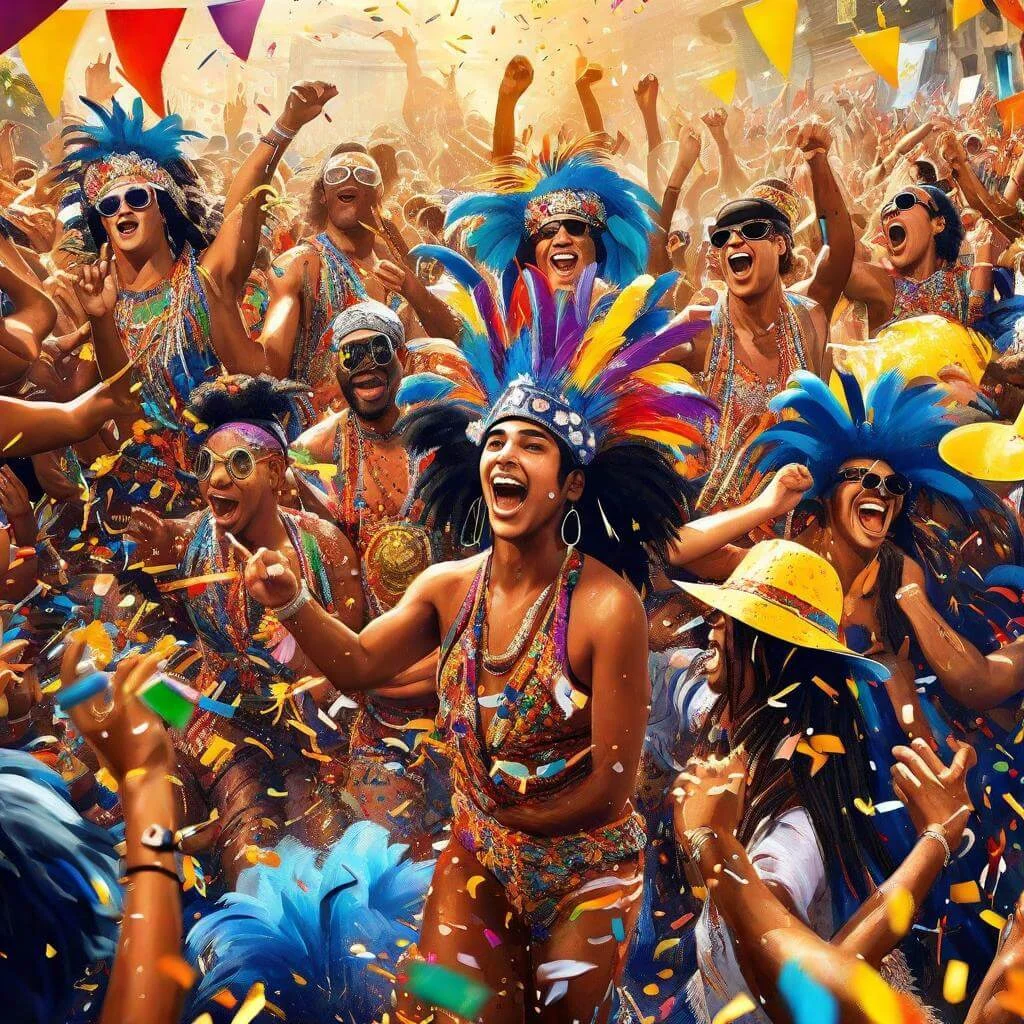
The introduction of samba music and dance
The introduction of samba music and dance was a pivotal moment in the evolution of Brazil Carnival. Samba, with its lively rhythms and infectious beats, became the heartbeat of the festival. It provided a platform for individuals and samba schools showcase their creativity, rhythm, and passion. The vibrant energy of samba the Carnival into a mesmerizing spectacle.
Carnival during different historical periods in
Brazil Carnival has witnessed different historical periods that shaped its form and expression. During the colonial period, the elite dominated the celebrations with extravagant parades. In early 20th century, African influences started to take center stage, adding a unique flavor to the festivities. The Carnival also played a significant role during the military dictatorship, with its subversive themes challenging the oppressive regime.
Symbolism and Themes of Brazil Carnival
The use of costumes and masks to convey meaning
Costumes and masks are not mere adornments in Brazil Carnival; they carry deep meanings. Each costume and mask is carefully designed to represent specific characters, deities, or cultural symbols. From the majestic costumes of the samba queens to the colorful masks of the revelers, every element adds to the overall spectacle and storytelling of the Carnival.
The representation of social issues through Carnival floats
Carnival floats serve as powerful platforms for addressing social issues and sparking conversations. These elaborately decorated and thematic floats often convey messages related to inequality, politics, environmental concerns, and cultural diversity. They provide a way for artists and participants to express their opinions and provoke thought among the spectators.
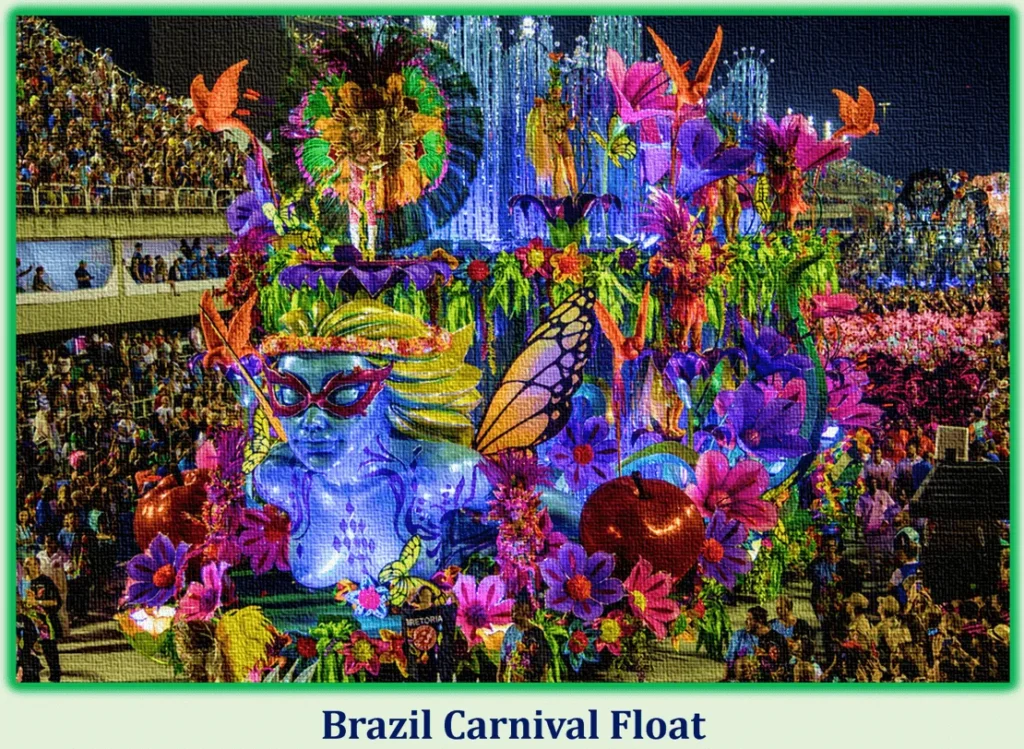
Themes such as freedom, equality, and cultural diversity
At the core of Brazil Carnival are themes of freedom, equality, and cultural diversity. The festival celebrates the freedom of expression and embraces people from all backgrounds. It serves as a reminder of the importance of equality and unity in a society that is often divided. The Carnival is a vivid display of Brazil’s rich cultural diversity and acts as a unifying force that brings people together.
Carnival in Rio de Janeiro the Ultimate Spectacle
The Samba Schools of Rio de Janeiro
The Rio Carnival is synonymous with the vibrant and exhilarating performances of the samba schools. These schools play a vital role in the preparations for the Carnival, showcasing the true essence of Brazilian culture and tradition.
The importance of samba schools in Carnival preparations
The samba schools are the heart and soul of the Rio Carnival. These schools bring together thousands of performers who spend months rehearsing, designing costumes, and composing music for their performances. Their dedication and teamwork are crucial to creating unforgettable Carnival experiences.

How these schools are structured and organized?
Each samba school consists of various wings, including a percussion section, dancers, float designers, and costume makers. The schools are organized hierarchically, with a president leading the overall operations and different directors overseeing specific aspects of the preparations.
The fierce competition and selection process
Rio de Janeiro’s Carnival is famous for its fierce competition among samba schools. Each year, a panel of judges evaluates the performances, considering factors such as creativity, execution, and overall impact. The winning school receives recognition and the honor of hosting the following year’s parade.
The Sambadrome: Home of Rio Carnival
The Sambadrome Marquês de Sapucaí serves as the main stage where the samba schools showcase their extraordinary skills and talent. This iconic venue witnesses the grand parade, which attracts millions of spectators both locally and internationally.
Overview of the iconic Sambadrome Marquês de Sapucaí
The Sambadrome is a monumental structure designed by the famous architect Oscar Niemeyer. Its purpose-built design ensures an optimal view for all attendees and provides a stage where samba schools can express themselves fully.
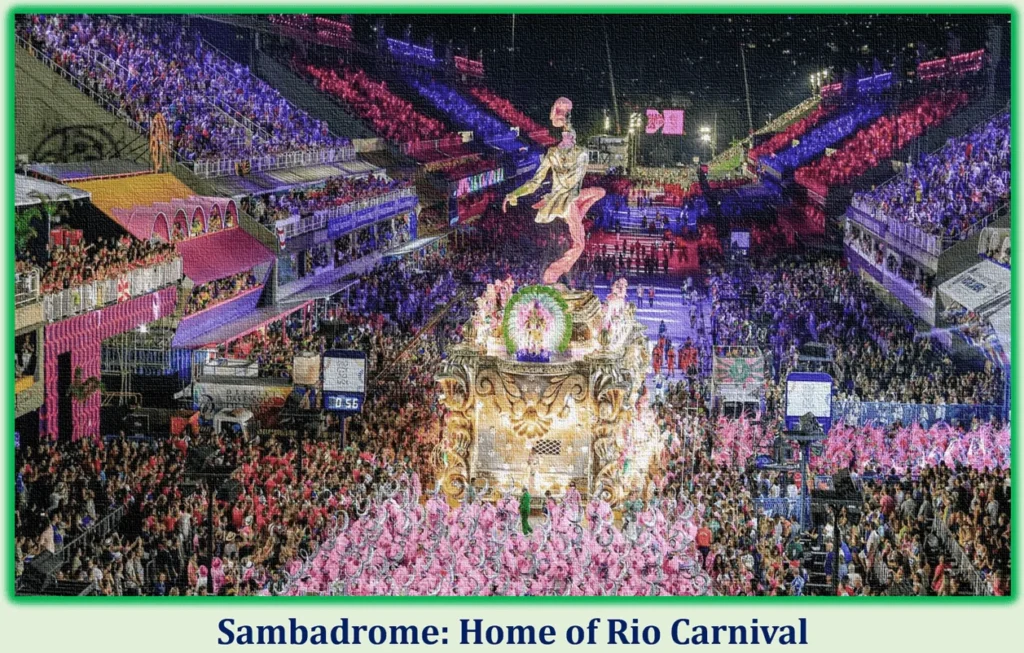
The grand parade and performances of samba schools
During the Carnival, the Sambadrome hosts a series of parades featuring the samba schools. Each school performs elaborately choreographed routines with vibrant costumes, synchronized movements, and infectious rhythms. Spectators are mesmerized by the spectacle and energy exuded by the performers.
Spectator experience and ticketing for the Sambadrome
Attending the Sambadrome is a must for anyone seeking an authentic Carnival experience. Tickets can be purchased in advance, allowing visitors to secure their spot and choose from various seating options. The Sambadrome offers a unique atmosphere that immerses spectators in the heart of the Carnival celebrations.
Beyond the Sambadrome: Street Parties and Blocos
While the Sambadrome is the focal point of the Rio Carnival, the streets of Rio de Janeiro also come alive with vibrant street parties known as blocos. These informal gatherings add another layer of excitement and spontaneity to the Carnival experience.
Exploring the vibrant street parties and blocos
Blocos are large groups of people who gather in the streets to dance, sing, and celebrate Carnival together. Each bloco has its own unique theme, music, and costumes, attracting participants and onlookers alike. Some of the most popular blocos include “Cordão da Bola Preta” and “Simpatia é Quase Amor.”
The unique atmosphere and spontaneous celebrations
What sets the street parties and blocos apart is the genuine joy and spontaneity that fills the air. People from all walks of life come together to celebrate, regardless of their background or social status. The energetic music, lively dancing, and colorful costumes create an unforgettable ambiance.
Tips for participating safely in street Carnival events
To fully enjoy the street parties and blocos, it’s important to prioritize safety. Here are some things to remember.:
- Travel in groups and stay aware of your surroundings.
- Avoid carrying valuable belongings and keep essential items secure.
- Stay hydrated and apply sunscreen regularly during the daytime events.
- Respect the local culture and traditions and follow the instructions of event organizers and authorities.
Carnival in Salvador: The Heartbeat of Bahia
The Carnival in Salvador is a vibrant and lively celebration that showcases the rich Afro-Brazilian culture and heritage of Bahia. This section will explore the pivotal role of Trio Elétrico, the significance of Afoxés, and the cultural movement of Bloco Afro in Salvador’s Carnival.
Trio Elétrico: The Sound of Salvador Carnival
The intoxicating rhythms and melodies of Trio Elétrico dominate the streets of Salvador during the Carnival. Originally introduced in the 1950s, the Trio Elétrico is a moving stage that carries musicians and amplifiers, spreading music and joy throughout the city.
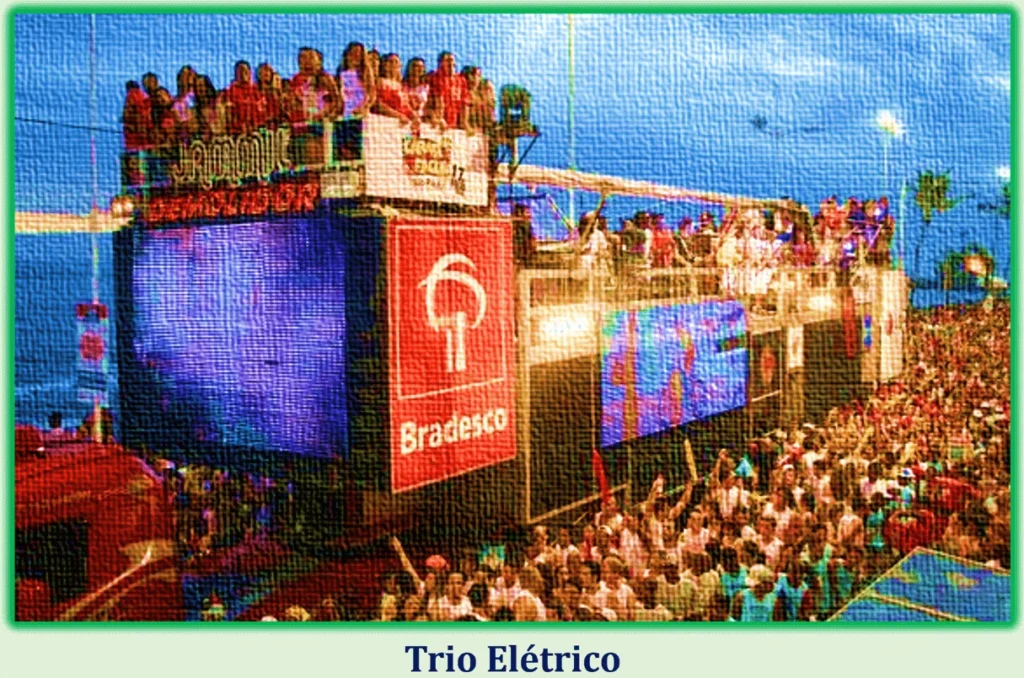
The role of Trio Elétrico in Salvador’s Carnival
The Trio Elétrico serves as the epicenter of Salvador’s Carnival, as it attracts thousands of revelers who dance and sing alongside the moving stage. It creates a sense of unity and togetherness, breaking down barriers and bringing people from all walks of life together.
The fusion of African rhythms with modern music genres
One of the remarkable aspects of Trio Elétrico is its fusion of traditional African rhythms with modern music genres such as reggae, samba, and axé. This amalgamation of styles creates an energetic and infectious sound that encapsulates the spirit of Salvador’s Carnival.
Iconic musicians and performances on the Trio Elétrico
Trio Elétrico has witnessed legendary musicians and performances over the years. Artists like Carlinhos Brown, Daniela Mercury, and Bell Marques have become synonymous with Carnival in Salvador, drawing massive crowds with their electrifying performances.
The Afoxés: African Heritage in Salvador
Afoxés, the mesmerizing Afro-Brazilian percussion groups, play a vital role in preserving and promoting the African heritage of Salvador. Understanding the significance of Afoxés and their contributions to the Carnival is crucial in appreciating the cultural richness of Bahia.
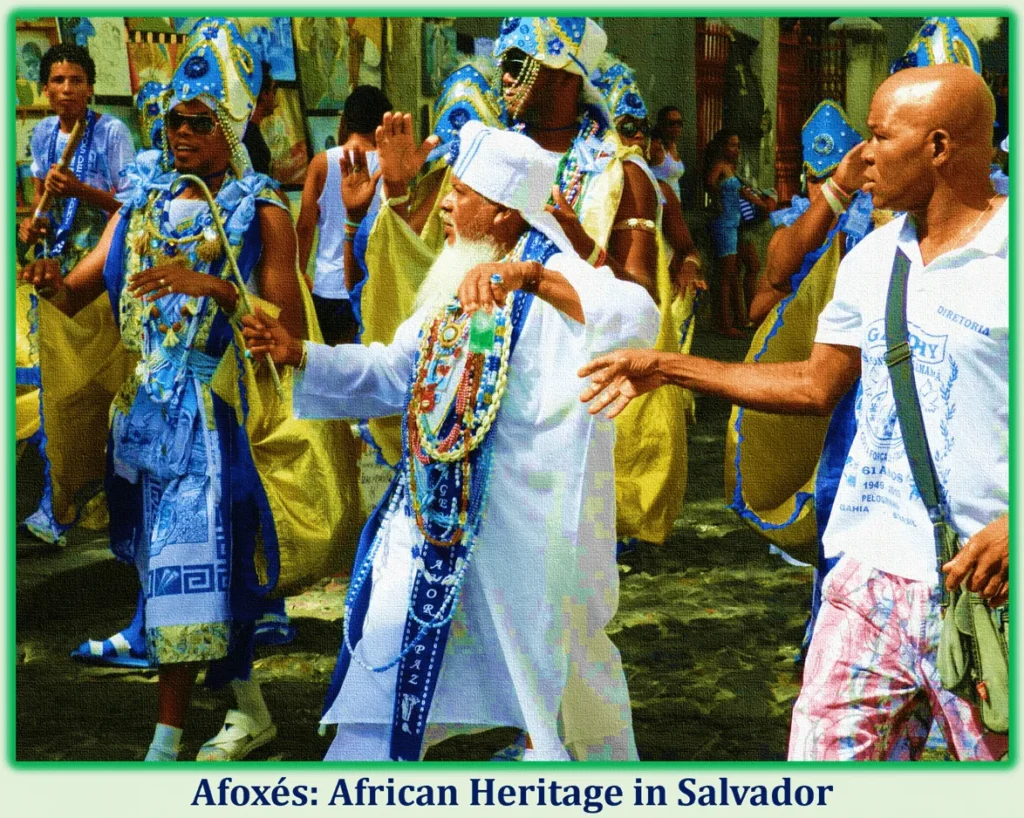
Understanding the significance of Afoxés in Carnival
Afoxés are deeply rooted in the African traditions brought to Bahia by enslaved individuals. These percussion groups pay homage to the spiritual and cultural practices of African ancestry, infusing the Carnival with a powerful sense of tradition and spirituality.
Preservation and promotion of Afro-Brazilian culture
Through their music, dance, and intricate costumes, Afoxés preserve and promote Afro-Brazilian culture during Carnival. They serve as a platform to educate and create awareness about the history, struggles, and contributions of Afro-Brazilians, encouraging cultural pride and appreciation.
Afoxé groups’ contributions to social movements
Afoxés have played a pivotal role in social movements aimed at combating racism and inequality. Their presence in Salvador’s Carnival serves as a powerful statement against discrimination, fostering inclusivity, and highlighting the ongoing struggle for social justice.
Bloco Afro: Celebrating Afro-Brazilian Identity
Bloco Afro is a cultural movement within Salvador’s Carnival that celebrates and empowers Afro-Brazilian identity. In this section, we will explore the origins of Bloco Afro, its emphasis on pride and empowerment, and the elements that make this movement so captivating.
Exploring the cultural movement of Bloco Afro
Bloco Afro emerged in the 1970s as a response to the marginalization and erasure of Afro-Brazilian culture. It introduced a new form of expression, combining rhythmic drumming, vibrant costumes, and contagious dance moves, reclaiming the streets of Salvador with a potent Afro-Brazilian identity.
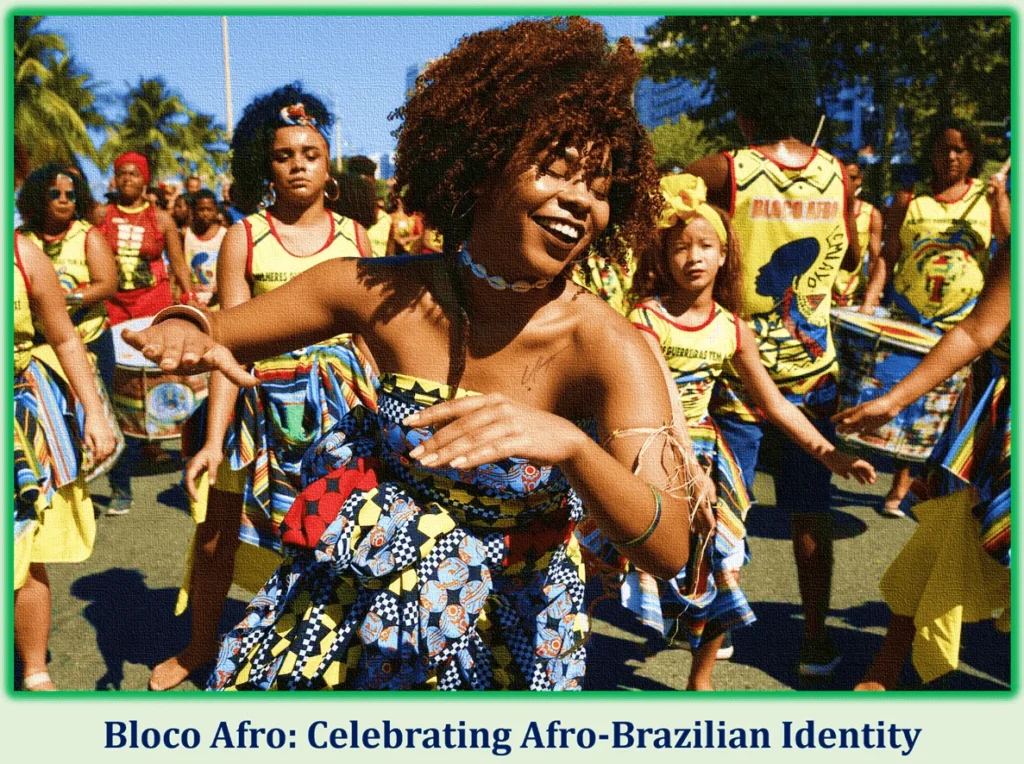
The emphasis on pride, identity, and empowerment
At the core of Bloco Afro is the celebration of Afro-Brazilian pride and identity. It serves as a way to honor the struggles and resilience of the Afro-Brazilian community while empowering individuals to embrace their heritage and cultural roots, fostering a sense of belonging and self-worth.
Elements of dance, music, and fashion in Bloco Afro
Bloco Afro showcases a dynamic fusion of dance, music, and fashion. The rhythmic beats of traditional percussion instruments such as atabaques and agogôs create an infectious energy, while the elaborate costumes featuring African-inspired prints and patterns make a visual statement. The synchronized dance moves further add to the captivating experience.
Carnival in Recife: A Multi-Cultural Extravaganza
Carnival in Brazil is a vibrant and diverse celebration, and nowhere is this more evident than in Recife. Recife is known for its unique cultural traditions that come alive during the Carnival season. In this section, we will explore two of the most significant aspects of Carnival in Recife: Frevo and Galo da Madrugada.
Frevo: The Rhythmic Pulse of Recife
Carnival is synonymous with music and dance, and when it comes to Recife, Frevo takes center stage. This energetic dance style originated in the streets of Recife and has become an integral part of the Carnival celebrations.
Unveiling the energetic dance style called Frevo
Frevo is a dance characterized by its energetic movements, acrobatics, and the use of small, colorful umbrellas. The dancers, known as “passistas,” showcase their agility and passion as they move to the fast-paced music. The combination of dance and music creates an atmosphere filled with joy and excitement, captivating both participants and spectators alike.
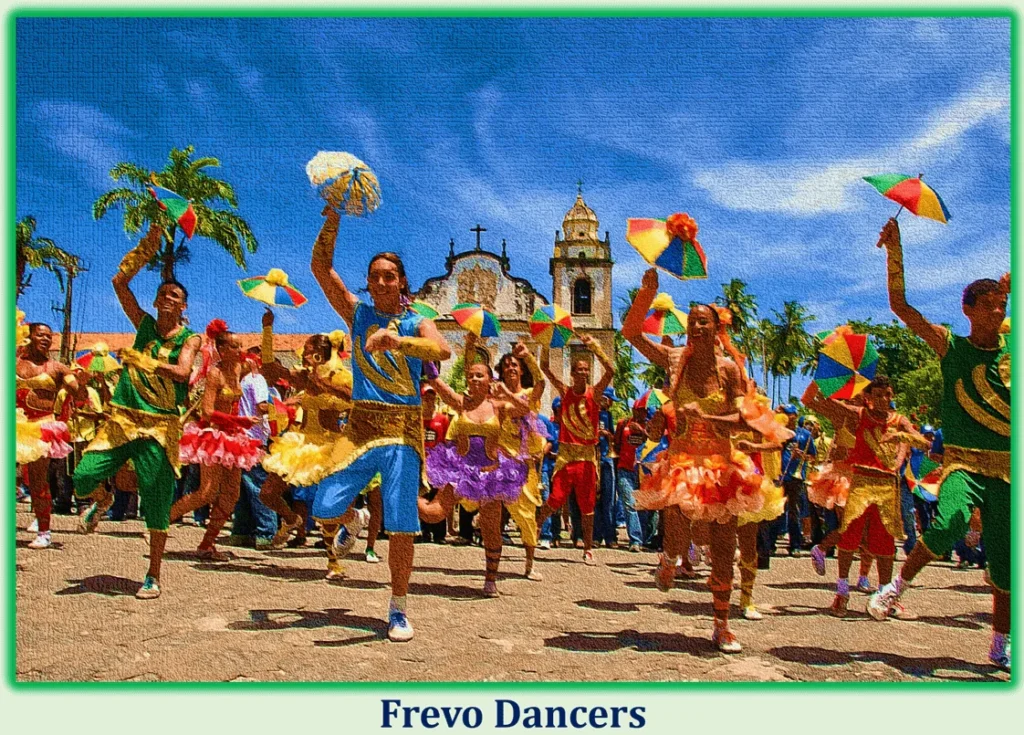
The history and incorporation of Frevo in Carnival
The origins of Frevo can be traced back to the late 19th century when bands playing brass and percussion instruments would entertain the crowds during Carnival. Over the years, this musical style evolved, incorporating elements of African, European, and indigenous cultures. Today, Frevo represents the cultural diversity of Recife and is an essential part of its Carnival celebrations.
Instruments and music associated with Frevo
To truly understand the essence of Frevo, one must appreciate the vibrant sounds produced by various instruments. The trumpet, trombone, saxophone, and percussion instruments such as the snare drum and Surdo come together to create the infectious rhythm of Frevo. The music, characterized by its fast tempo and intricate melodies, sets the stage for the energetic dance movements and adds to the overall vibrancy of Carnival in Recife.
Galo da Madrugada: The Largest Carnival Block
While Carnival is known for its grand parades, no parade can compare to the magnitude of Galo da Madrugada in Recife. Galo da Madrugada holds the Guinness World Record for being the largest Carnival block, attracting millions of people from all over the world.
The iconic Galo da Madrugada parade in Recife
Galo da Madrugada, which translates to “Rooster of Dawn,” is a massive parade that takes place in the streets of Recife. The parade is led by a giant rooster float, beautifully adorned with colorful feathers and accompanied by a lively band. The sheer scale of the parade is breathtaking, with countless people joining in the festivities.

Record-breaking crowds and festive excitement
Year after year, Galo da Madrugada draws larger crowds, breaking its own records. The streets are packed with enthusiastic revelers, all adorned in vibrant costumes and singing and dancing to the rhythm of the music. The excitement is contagious, and you can’t help but be swept up in the joyous atmosphere that permeates every corner of Recife during this time.
Traditions, costumes, and cultural significance of Galo da Madrugada
Galo da Madrugada is not just about the parade; it is deeply rooted in local traditions and holds great cultural significance. People spend months preparing their costumes, which often reflect their cultural heritage or pay homage to famous figures in Brazilian history. The parade serves as a platform for local artists, musicians, and performers to showcase their talent, further enhancing the cultural tapestry of Recife.
Maracatu: Afro-Indigenous Heritage in Carnival
In addition to Frevo and Galo da Madrugada, another significant aspect of Carnival in Recife is Maracatu. Maracatu is a traditional Afro-Indigenous performance art form that carries with it centuries of history and cultural symbolism.
Exploring the mystical roots of Maracatu
Maracatu traces its roots back to the time of slavery when African traditions merged with indigenous rituals. It was a way for the enslaved population to preserve their cultural heritage in the face of oppression. Maracatu combines music, dance, and theater to create a captivating and immersive experience.
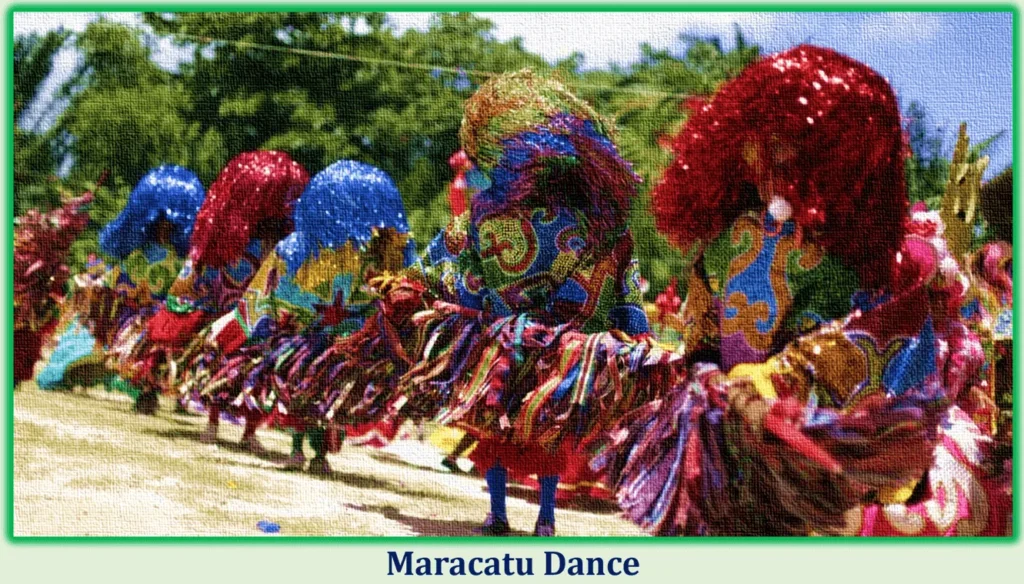
Symbolism and rituals embedded in Maracatu performances
Every aspect of a Maracatu performance is laden with symbolism and carefully choreographed rituals. The royal court, consisting of a queen, king, and other prominent figures, leads the procession, accompanied by drummers, singers, and dancers. The costumes and masks worn by the performers represent ancestral spirits and mythical creatures, adding an otherworldly element to the performance.
How Maracatu continues to evolve and unite communities?
While Maracatu has deep historical roots, it is a living art form that continues to evolve and adapt to the changing times. Today, it serves as a powerful tool for cultural expression and community cohesion. Maracatu groups, known as “Nações,” are present throughout the year, organizing rehearsals and performances that not only keep the tradition alive but also foster a sense of belonging and togetherness among community members.
Brazil Carnival Today: Challenges and Future Directions
Environmental Impact and Sustainability Concerns
Brazil Carnival, the world-renowned festival of music, dance, and vibrant costumes, captures the hearts and souls of millions around the globe. However, the extravagant celebrations are not without consequences. As we delve into the present-day Brazil Carnival, it is crucial to address the pressing issue of its environmental impact and sustainability concerns.
Examining the ecological consequences of Brazil Carnival
The sheer scale of Brazil Carnival brings forth several environmental challenges. The excessive use of natural resources, such as water and electricity, contributes to the depletion of these vital elements. Moreover, the disposal of tons of waste, including plastic materials from costumes and food containers, further exacerbates the ecological consequences.
Strategies and initiatives for a more sustainable Carnival
To combat these environmental concerns, various organizations and communities are mobilizing efforts to promote a more sustainable Carnival. For instance, recycling programs have been implemented to minimize waste accumulation. Additionally, alternative energy sources, such as solar and wind power, are being explored to reduce the festival’s carbon footprint.
Balancing tradition and environmental responsibility
While the push for sustainability is vital, it is crucial to strike a balance between tradition and environmental responsibility. Preservation of Brazil’s rich cultural heritage is of utmost importance. Therefore, efforts should focus on finding innovative solutions that do not compromise the essence of Carnival while minimizing its ecological impact.
Social Inclusion and Accessibility in Carnival
Brazil Carnival is not only a celebration of culture and joy but also serves as a platform for addressing social inequality and exclusion within society.
Addressing issues of social inequality and exclusion
Historically, Brazil Carnival has faced criticism for perpetuating social inequality, with marginalized communities facing limited opportunities for participation. Efforts have been made to address this issue by giving voice to underrepresented groups and challenging traditional power dynamics within the festival.
Efforts to promote diversity and accessibility in Carnival
To foster diversity and ensure accessibility, organizations have launched initiatives focused on inclusion. This includes creating opportunities for individuals with disabilities, promoting racial and gender diversity, and providing platforms for marginalized groups to express their identities and experiences through their performances.
Community engagement and initiatives for the marginalized
Community engagement plays a crucial role in developing a more inclusive Brazil Carnival. Collaborating with local communities and marginalized groups enables the creation of programs that cater to their specific needs and aspirations. Providing support, resources, and training workshops empower these communities, ensuring their active participation and representation in the festivities.
The Future of Brazil Carnival in a Changing World
As the world rapidly evolves, so too must Brazil Carnival adapt to remain relevant while preserving its authentic essence.
Adapting to technological advancements and digital presence
In an increasingly digital age, Brazil Carnival must embrace technological advancements to enhance its reach and engage with a global audience. Utilizing social media platforms, live streaming performances, and virtual reality experiences can bring the festival to people beyond its physical boundaries.
Impact of globalization and cultural exchange on Carnival
Globalization has facilitated the exchange of cultural influences, enriching Brazil Carnival with diverse artistic expressions. The incorporation of international music genres, dance styles, and costume designs adds an element of novelty and cross-cultural appreciation to the festivities.
Preserving the authenticity and essence of Brazil Carnival
As Brazil Carnival evolves, preserving its authentic essence becomes paramount. It is imperative to strike a balance between embracing innovation and safeguarding the elements that make the festival uniquely Brazilian. By reimagining traditional practices and infusing them with contemporary creativity, Brazil Carnival can continue to captivate audiences while maintaining its cultural identity.
“Let the rhythm of Brazil Carnival guide us towards a future of sustainable joy and inclusivity.”
Conclusion & FAQs
Brazil Carnival, from Rio to Salvador, is a celebration that truly embodies the spirit of joy and unity. Trio Elétrico, Afoxés, and Bloco Afro represent the heartbeat of this festival, embodying the essence of joy, unity, and empowerment. With its samba schools, the iconic Sambadrome, and the vibrant street parties, the Carnival offers an unparalleled experience for locals and tourists alike. Whether you choose to witness the grandeur of the Sambadrome or immerse yourself in the spontaneous celebrations of the blocos, Brazil Carnival promises an unforgettable journey into the heart of Brazilian culture.
Moreover, Brazil Carnival is not just a celebration but a vibrant display of cultural heritage and community unity. While facing environmental impact and social inclusion challenges, the festival seeks to strike a delicate balance between tradition and progress. By adopting sustainable practices, promoting diversity, and embracing technological advancements, Brazil Carnival can navigate a changing world while preserving its glorious essence. From its multicultural roots to the inclusive and vibrant atmosphere it creates, the Carnival truly encapsulates the essence of joy and celebration from Rio to Salvador. So, join the festivities, let the samba rhythms move your feet, and experience the magic of Brazil Carnival firsthand.
Frequently Asked Questions (FAQs)
When does Brazil Carnival take place?
Brazil Carnival occurs annually, usually in February or March, in the days leading up to Ash Wednesday.
Can tourists participate in Brazil Carnival events?
Absolutely! Tourists are welcome to join the festivities, attend parades, and engage in street parties. However, it’s important to stay informed about safety precautions and respect local customs.
Is Brazil Carnival only about big cities like Rio de Janeiro and Salvador?
No, Brazil Carnival is celebrated throughout the country, with various cities holding unique and diverse Carnival traditions. While Rio de Janeiro and Salvador are widely known, destinations like Recife, Olinda, and São Paulo also offer captivating Carnival experiences.
Do I need to purchase tickets for Brazil Carnival events?
Yes, tickets are required for attending Carnival events held in venues like the Rio Sambadrome. However, many street parties and blocos are free for everyone to join.
Can I wear a costume during Brazil Carnival?
Wearing costumes is strongly encouraged during Brazil Carnival! Dressing up in vibrant attire allows you to fully immerse yourself in the festive spirit and join the colorful parades and street celebrations.
